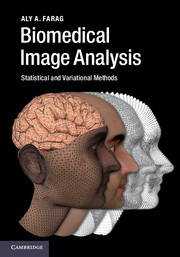Book contents
- Frontmatter
- Dedication
- Contents
- Preface
- Nomenclature
- 1 Overview of biomedical image analysis
- Part I Signals and systems, image formation, and image modality
- 2 Overview of two-dimensional signals and systems
- 3 Biomedical imaging modalities
- Part II Stochastic models
- Part III Computational geometry
- Part IV Variational approaches and level sets
- Part V Image analysis tools
- Index
- References
3 - Biomedical imaging modalities
from Part I - Signals and systems, image formation, and image modality
Published online by Cambridge University Press: 05 November 2014
- Frontmatter
- Dedication
- Contents
- Preface
- Nomenclature
- 1 Overview of biomedical image analysis
- Part I Signals and systems, image formation, and image modality
- 2 Overview of two-dimensional signals and systems
- 3 Biomedical imaging modalities
- Part II Stochastic models
- Part III Computational geometry
- Part IV Variational approaches and level sets
- Part V Image analysis tools
- Index
- References
Summary
Introduction
Methods of examining the anatomy and function of living organisms have advanced immensely over the past century. Biomedical imaging has evolved in terms of types of imaging system (modalities) and capabilities, and has improved our understanding of biological systems. It has affected the quality of our lives by transforming various medical practices from arts to science, enabling better healthcare administration, and leading on average to longer and healthier lives. The technology also has an economic impact: vast numbers of technical professionals (chemists, mathematicians, physicists, engineers, and computer scientists) work in companies making biomedical imaging devices, or in research laboratories and hospitals. One chapter cannot hope to cover a vibrant and ever-dynamic field; we will merely scratch the surface in understanding the process of image formation in some of the common imaging modalities. There are more specialized books, periodicals, and manufacturers’ reports that should be consulted by readers interested in delving into the field of biomedical imaging.
This chapter serves as a brief tour of a field of ever-expanding diversity and capabilities. The focus, however, will be on the imaging modalities that have guided the development of the basic theories and approaches to image analysis covered in the subsequent chapters of this book. We concentrate on image analysis approaches that have been well-studied for images from two broad categories of imaging sensors: those based on ionizing radiations (e.g. X-rays and computed tomography) and those based on magnetization (e.g. magnetic resonance imaging). Positron emission tomography (PET), ultrasound imaging, laser imaging, thermal infrared imaging and other modalities are also important, but this chapter will not cover all of these.
Information
- Type
- Chapter
- Information
- Biomedical Image AnalysisStatistical and Variational Methods, pp. 39 - 76Publisher: Cambridge University PressPrint publication year: 2014
